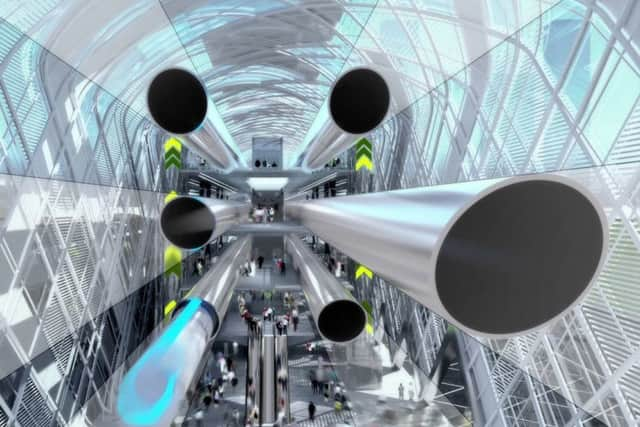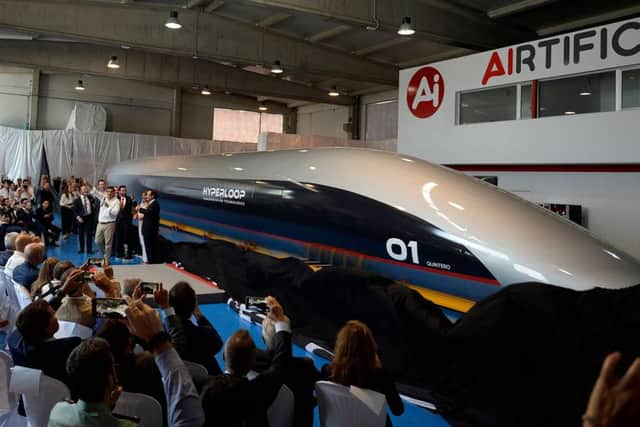‘Leeds to Manchester in seven minutes’: Why the ‘hyperloop’ is the future of public transport
When the transport infrastructure of the North is discussed it is often compared to that of the Victorian era.
Planned improvements for high-speed rail connecting the great cities of the North have, quite rightly, been welcomed in the region, with the scheme on track to deliver a shortened journey time between Leeds and Manchester of just 26 minutes.
Advertisement
Hide AdAdvertisement
Hide AdBut what if this journey could be reduced to seven minutes – and at a cost significantly lower than that involved in the construction of a high-speed railway infrastructure?


It may sound like the realm of science fiction but such a scheme is currently being seriously considered.
Campaigners want the North of England to become one of the first places in the world to adopt hyperloop technology.


What it is
A concept mooted by billionaire entrepreneur Elon Musk, hyperloop involves taking a magnetic levitation (maglev) train and putting it in an airtight tube so that it encounters no air resistance, allowing it to travel at incredibly fast speeds of more than 700 mph. The technology is being actively pursued by several large-scale companies, including Virgin, and is already at fully-functional prototype stage, having been successfully trialed in a number of locations.
Advertisement
Hide AdAdvertisement
Hide AdExploratory discussions are underway across the world to see who will be among the first to attempt to implement the technology, with India, UAE and several locations in the United States giving hyperloop serious consideration.
Following a global competition, Virgin Hyperloop has selected 10 destinations worldwide to begin looking seriously at introducing the technology, two of which are in the UK and one of which would connect up the North of England.


Dr Alan James, a partner at Expert Alliance and a former VP of global business development at Virgin Hyperloop One, is convinced that a hyperloop system which connects the major urban areas of the North of England would be far more transformative than anything that either HS2 or Northern Powerhouse Rail could muster.
Speaking to Yorkshire Vision he said: “The need is greater here and the opportunity here is actually greater. The North of England corridor is a very good fit.
Advertisement
Hide AdAdvertisement
Hide Ad“There are enough people, there are enough major metro centres, there are airports, there are major retail destinations – the kind of places that generate passenger flow.
“And what the hyperloop would do differently to, say, conventional railway is that it would network it all.


“Long term, if the cities of the greater North wish to combine their economies and all the benefits that come from having a single labour pool, then a truly transformational intervention like that will truly pay dividends.
“If Liverpool and Manchester are five minutes apart and Leeds and Manchester are six minutes apart, that is genuinely transformational.
Advertisement
Hide AdAdvertisement
Hide Ad“It is not about the tech, it is about the connectivity. If Leeds gets a tram, it has a tram and it’s a tram for Leeds. If Leeds gets a hyperloop, Leeds also gets a network that is connected to Liverpool, Manchester and Newcastle. And Newcastle gets Leeds, Liverpool gets Manchester.
“And what that means is a huge amount of significant universities, 15 million people, all connected with journey times of sub-30 minutes.
“You have actually got journey times between the major urban centres which are less than taking the tube in London.”
More agile than trains
The reason why so many are finding hyperloop to be so attractive does not conclude with the speedier connectivity.
Advertisement
Hide AdAdvertisement
Hide AdEven the fastest trains struggle when climbing hills and cannot bank around corners, concerns which are not applicable to the hyperloop model.
It also takes up far less space than a high-speed rail route would do. Dr James claims the best place for hyperloop to run would be down the central reservation of a motorway, avoiding the need for despoiling national parks.
“The hyperloop doesn’t care,” he said. “It can be over the ground, at ground level or under the ground. It is by definition its own tunnel.
“A hyperloop takes two square metres for every metre forward, because you only buy the land where the piers stand.”
Advertisement
Hide AdAdvertisement
Hide AdWith the vast majority of the infrastructure above the ground it means that most of the network would be paid for via air rights deals, similar to the erection of telephone cabling.
Answering the naysayers
As with all new technologies, a challenge will present itself in overcoming those who may harbour doubts about the safety of such high-speed technologies.
However, those in support of hyperloop point out that the technology compares favourably with that of aerospace, which is still rated as one of the safest methods of transport.
Both involve a cylindrical vehicle, constructed of metal which operates in a low-pressure environment.
Advertisement
Hide AdAdvertisement
Hide AdThe difference is that a hyperloop operates in a totally controlled environment in which weather is never a factor – and you are not thousands of feet off of the ground.
Another challenge comes in persuading people to back a new scheme that so demonstrably challenges plans for other high-speed technologies.
With so much political and financial capital sunk into a high-speed rail link between London and the North already, the likelihood of convincing Whitehall departments to abandon HS2 may at this stage seem slight, but Dr James has hope.
“At the level of spend, whatever it turns out to be, do we want to build ourselves yesterday’s high-speed rail system or do we want to take advantage of the massive step-change in transport technologies that is coming along and get an advantage?”
How hyperloop can be brought to Yorkshire
Advertisement
Hide AdAdvertisement
Hide AdDr Alan James has spent much of his life involved in the transport sector and is convinced that the impetus for a hyperloop project would come from the private sector alone.
“All my experience over the last 20 years points me to the fact you can’t start this as a Government-led project,” he said. “It has to be a business-led project. In order to do that you need to make it investable. I genuinely think that this has traction. Frankly, we can’t carry on like we are at the moment.”
He proposes a different model to that seen to implement High Speed Rail 2, one that is very much led by business.
“What you do not do here is set up a billion-pound company to go and build a piece of infrastructure. What you set up is a million-pound company.”
Advertisement
Hide AdAdvertisement
Hide AdSpecifically, he boils this down to two things: who is going to use it and who will pay for it.
He sees Government’s role as more being confined to putting into place an effective sovereign guarantee underneath the debt to allow the private sector to begin funding it in real time.
“If Government comes underneath and says that, actually, the infrastructure development company just has to make it available to a given specification, budget and schedule, we will make a payment on a biannual basis on that infrastructure being available for use, that immediately takes out the demand risk and that enables sovereign wealth funds and pension funds to loan at the kind of rates they are looking for.”
